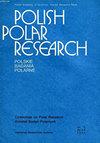Morphological differentiation and phylogenetic homogeneity in Usnea aurantiaco-atra reveal the complexity of lichen symbiosis
IF 0.8
4区 地球科学
Q4 ECOLOGY
引用次数: 1
Abstract
Usnea aurantiaco-atra is the dominant flora around King George Island, Antarctica, whose specimens exhibited various phenotypes, even for those with the same ITS sequences in both mycobiont and photobiont. A comprehensive analysis of morphological traits of U. aurantiaco-atra including the reproductive structures, growth forms and ornamentation, cross section of the branches, and the substratum was carried out. Four arbitrary groups were identified based on their reproductive characters, but these groups cannot be distinguished from molecular phylogenetic trees based on fungal or algal ITS sequences. Further, the complicated morphological diversity of the thalli with the same ITS haplotypes in both mycobiont and photobiont suggest that some other factors in addition to the symbionts could influence the morphology of lichens. This implies that lichen is indeed a complex-mini-ecosystem rather than a dual symbiotic association of fungus and alga. Also, a lichenous fungi Phacopsis sp. was identified based on its anatomical characters and ITS sequence, which was also responsible for the black burls-like structures on U. aurantiaco-atra.摘要aurantiaco-atra的形态分化和系统发育同质性揭示了地衣共生的复杂性
Usnea aurantiaco-atra是南极洲乔治王岛(King George Island)的优势区系,其标本表现出不同的表型,即使在真菌和光生物中ITS序列相同的标本也表现出不同的表型。对金银花的生殖结构、生长形态和纹饰、枝条截面、基质等形态特征进行了综合分析。根据其生殖特征鉴定出4个任意类群,但这些类群无法与基于真菌或藻类ITS序列的分子系统发育树区分开。此外,具有相同ITS单倍型的菌体在菌体和光体中具有复杂的形态多样性,这表明除共生体外,还有其他因素可能影响地衣的形态。这意味着地衣实际上是一个复杂的微型生态系统,而不是真菌和藻类的双重共生关系。此外,根据其解剖学特征和its序列鉴定出一种地衣真菌Phacopsis sp.,该地衣真菌也是造成U. aurantiaco-atra黑色瘤状结构的原因。
本文章由计算机程序翻译,如有差异,请以英文原文为准。
求助全文
约1分钟内获得全文
求助全文
来源期刊

Polish Polar Research
ECOLOGY-GEOSCIENCES, MULTIDISCIPLINARY
CiteScore
2.00
自引率
7.70%
发文量
0
审稿时长
>12 weeks
期刊介绍:
The quarterly Polish Polar Research edited by the Committee on Polar Research of the Polish Academy of Sciences is an international journal publishing original research articles presenting the results of studies carried out in polar regions.
All papers are peer-reviewed and published in English.
The Editorial Advisory Board includes renowned scientist from Poland and from abroad.
 求助内容:
求助内容: 应助结果提醒方式:
应助结果提醒方式:


